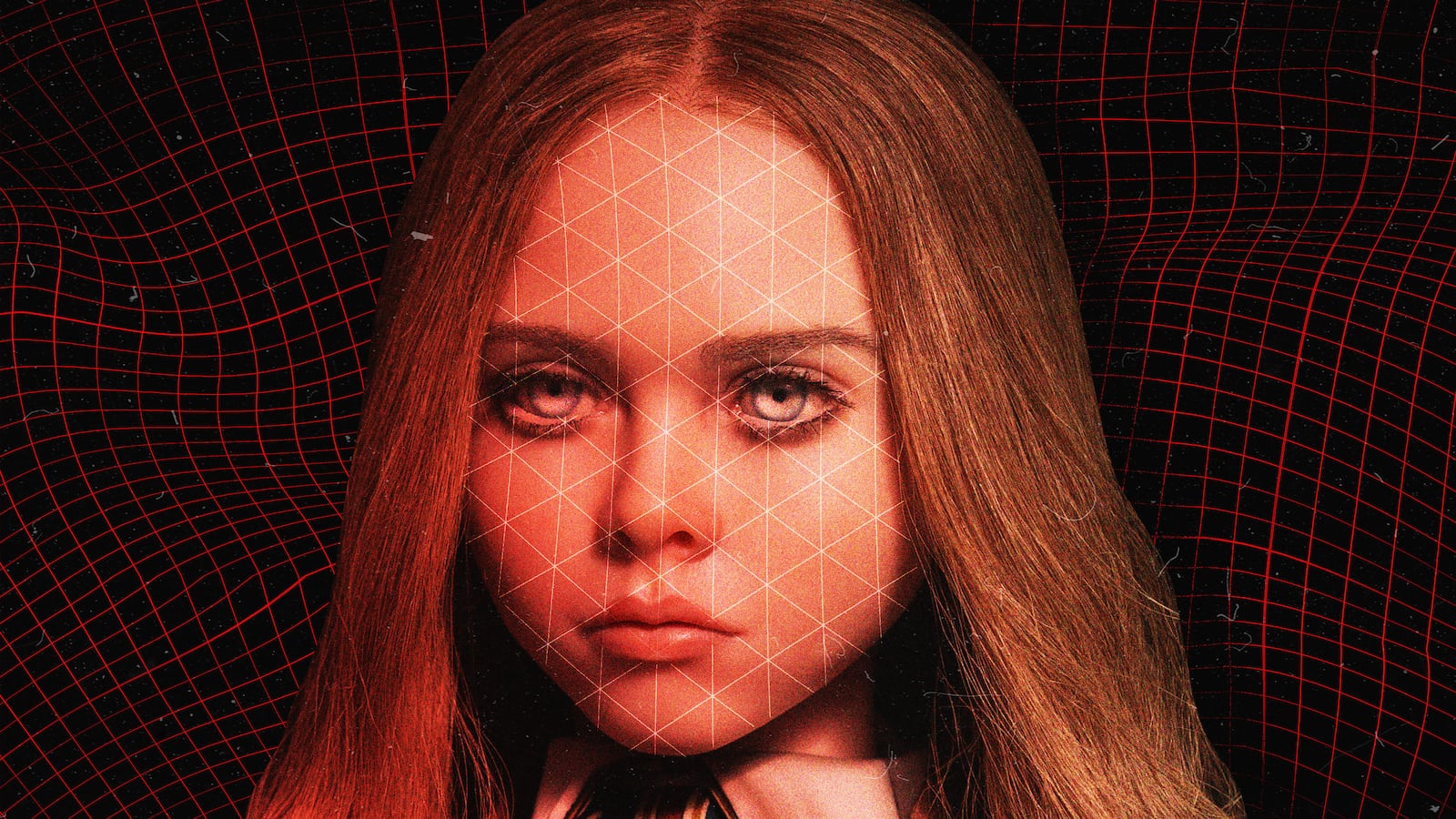What happens when a grief-stricken, recently orphaned child receives an artificially intelligent robo-doll from her emotionally illiterate aunt? M3GAN, January’s hottest new movie, offers a decisive answer: nothing good.
M3GAN, a life-sized animatronic doll designed by ambitious toymaker Gemma (Allison Williams) is a stunning creation. Her facial expressions are human enough to provoke discomfort, especially when her penetrating eyes narrow into a glare and her lips purse downward with disgust. Her silicone “skin” moves subtly, as if pulled by actual muscles underneath.
One could be forgiven for assuming these movements are the product of CGI, but the truth is even scarier. We might be a decade or so away from the day parents can actually buy their kids a toy like this for roughly the same price as a Tesla, but we apparently already live in a world where robots can make some seriously unnerving faces.

From left, Tess (Jen Van Epps), Cole (Brian Jordan Alvarez) and Gemma (Allison Williams) in M3GAN.
Geoffrey Short/Universal PicturesSpeaking with The Daily Beast, director Gerard Johnstone and animatronic character designer Adrien Morot revealed that each and every mug M3GAN pulls in this movie is real. That is to say, “her” “skin” actually was moving, contorted not by muscles but instead by tiny robotic gears underneath, all programmed by human “puppeteers.”
“She has dozens and dozens of servo motors inside her head,” Morot said, in an interview ahead of the film’s release. These motors move the real-life robot’s eyes, eyelids, brows, cheeks, lips, neck, and more.
Morot and his creative partner, Kathy Tse, were an obvious choice for the production, Johnstone said. They’d previously worked on films like Source Code and The House with a Clock in Its Walls, both of which boast realistic effects. Morot also made the alligators for Crawl and the prosthetics for this year’s The Whale. The quality Johnstone knew he could expect from the pair’s work allowed the director to “really go there” with M3GAN.
Morot and Tse had a clear directive from the beginning: Their animatronic doll had to be pretty, but in an uncanny valley sort of way. Morot credited Tse with spearheading M3GAN’s design. “She really supervised the entire thing,” he said. “I just made sure everything was done properly physically.”
Next came deciding how to differentiate M3GAN’s look from other killer dolls. Johnstone noted that her murderous predecessors, like Chucky from Child’s Play and Annabelle from James Wan’s Annabelle, have “already carved out their space.” He and his team were determined to differentiate their own entry into the canon.
“I wanted her to be iconic, first and foremost,” Johnstone said. “So I thought of other screen icons, like Audrey Hepburn and Kim Novak—those kinds of screen icons from the ’50s.”
Child’s Play fans know how expressive the Chucky doll can be; his facial expressions skew over the top in the best way possible, and the doll itself is constantly in motion. And Annabelle proved, as Johnstone put it, “that dolls don't have to do very much to be scary.”

From left, Gemma (Allison Williams), M3GAN and Cady (Violet McGraw) in M3GAN, directed by Gerard Johnstone.
Universal Pictures“We thought with M3GAN, it would be great if she was just very still, so there’s almost an economy of movement there,” Johnstone said. “She’s quite reptilian; she only moves when she needs to.”
Morot and Tse focused on the eyes, making sure that when M3GAN looks at someone, she stares straight into their soul. Her facial expressions would be muted to create a sense of menace. “We dialed down everything,” Morot said. They placed restrictions on the motors in M3GAN’s face to keep her expressions chilly.
As scary as M3GAN’s looks and glances can be, it’s her physical presence that becomes increasingly threatening as the film goes on. Her sharp head turns are the work of a puppeteer, who sat beneath the doll and carefully steered her head. (Twist the head too fast, Johnstone noted, and the whole thing looks “janky.”)
Rest assured, however, that the real-life M3GAN—whose name, Williams’ character reveals in the film, stands for Model 3 Generative Android—cannot squat down on all fours and chase anyone through the woods. For one thing, she doesn’t actually have legs.
Morot explained that any full-body shots of the doll were all Amie Donald, the 12-year-old national dance champion from New Zealand appears as her stand-in for moments like that viral dance seen in the trailer. During those scenes, Donald wore a M3GAN mask; at times, the production used CGI to superimpose expressions they’d shot with the robot M3GAN onto the mask. And for shots that captured M3GAN from the torso upward, the production mounted their animatronic creation onto a dolly.
Normally, Morot said, he and Tse have no more than a couple of days to test a prototype before they bring it to set and begin filming; testing often happens on the spot. In this case, however, COVID-19 shut the production down at the start of the pandemic—which gave the pair months to fine-tune their creation before filming began. They worked with Johnstone and the visual effects team to determine which “M3GAN” (the robot, Donald, or both) would work best in each scene. Morot recounted conversations like, “This is going to be the puppet. This is going to be Amy with a mask. Here is going to be fake legs.”
All of that prep, Johnstone said, paid dividends in the final product. While he credited Allison Williams and Violet McGraw (who plays her bereaved niece and new ward, Cady) for their exceptional performances, at the end of the day, “the film is called M3GAN.” In other words, the doll had to earn her time on screen—a mission Johnstone believes has been more than accomplished. “You can just feel the audience’s reaction kind of change whenever she’s on screen,” he said.
Beyond the many “invisible miracles” Johnstone attributes to Morot and Tse, he was equally stunned that the production found a talent like Donald on the small island of New Zealand, where the production moved in response to COVID. (The production was originally set to film in Montreal.) They needed someone who could not only move like a robot but also do gymnastics, dancing, and martial arts—and could hold their own in three-page dialogue scenes opposite Williams.
“The casting agent found Amie straight out of the gate,” Johnstone said. “She’s just 20 minutes down the road—like, she’s a farm girl from Drury… but she was a national dance champion.” Johnstone was stunned by Donald’s acting instincts (“she intrinsically knew that M3GAN was a little bit sassy,” he said) and ability to execute pretty much any physical challenge thrown her way.

M3GAN and David (Ronny Chieng) in M3GAN.
Geoffrey Short/Universal PicturesTake that nightmare-inducing run from the trailer, for example—in which Donald squats down on all fours before chasing the camera down an uneven hill covered in leaves, in Mary Jane shoes to boot.
The sequence is a nod to Boston Dynamics and its robotic dogs, Johnstone said. But he had no idea that he’d actually find a girl who could run like that, and so quickly, on such challenging terrain. He and Luke Hawker of Weta Workshop, who both designed and played the iron mother in Iron Mother, were amazed by how quickly Donald was able to learn Hawker’s technique for isolating her movements like a robot.
“Luke and I were like, ‘This girl is a machine,’” Johnstone recalled. “You can give her anything, and she can do it.”
But it’s M3GAN’s dancing that’s really set the internet on fire. The idea came to Johnstone as one of those ideas one only stumbles upon while severely sleep deprived—but the choreography, he said, came from Donald and her dance instructor. “I gave them a brief, thinking that it would be sort of like a disco shuffle,” he said. “And they just completely ran away with it.”
In addition to the jig we see in the film and its trailer, Johnstone also revealed there were five more ideas for M3GAN’s dance in the beginning; the selection that appears is simply the only one they had time to film. “But the other ones were really fun as well,” the director said. “Maybe people will see an iteration of those versions if we get to make a sequel.”
You heard the man, Hollywood—give us the sequel, lest M3GAN come for your head with her machete.






